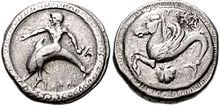Greek coinage of Italy and Sicily
Greek coinage of Italy and Sicily originated from local Italiotes and Siceliotes who formed numerous city states.The city of Posidonia (Paestum) had received its name from Greek god Poseidon whose portrait they struck in their coinage.It was originally known as Lindii after their home town Lindos, but the city was renamed after the river Gelas.[2] Some tyrants in Magna Graecia advertised their victories in the Olympic Games by striking coinage that referred to these specific achievements.[6] The region of Magna Graecia included originally Greek cities such as Cumae, Herakleia, Kaulonia, Kroton, Lokroi, Neapolis, Metapontum, Sybaris, Taras, Thurii and Rhegion.This downward evolution was significantly affected by the financial strain caused by warfare for the Greek polities.For instance, countering the expansion of Rome caused considerable pressure for the Italiote city states.Katana, founded in 730 BC by colonists moving out of the city of Naxos, was known for its masterful engravers whose work resulted in very fine coinage.[12] Nacona was a small Greek town in Sicily the existence of which, at an unknown location, is confirmed by coins bearing the legend "NAKONAION", or "ΝΑΚΩΝΑΙΩΝ”.In the 5th century a strong government and widely militarized society ruled by tyrants left behind abundant coinage.


ItaliotesSiceliotesHellenisticSouthern ItalyMagna GraeciaRoman provincial currenciesHistory of coins in ItalySybarisMinervaKrotonHerculesPosidoniaPoseidonseahorsesNeapolisRhodianLindosOlympic GamesList of Hellenistic monetary standardsCorinthianAttic standardHerakleiaKauloniaLokroiMetapontumThuriiRhegionmintingHistory of TarantocavalrymanGreek worldweight standards of Hellenistic coinagePyrrhic WardebasementSicilian WarsPunic WarsChalcideanDionysosSatyrsDionysios ITauromenionHimeraZancleNaconaPunic coinsstatersCarthaginianSecond Punic WarRoman provincial currencyCoinage of the Social War (91–88 BC)Greeks in ItalySicelsJames MillingenBythiniaKushansMassaliaPontusRhodesSeleucidsGandharaAttic (Euboic) weightCistophoric weightPhoenician weightAncient Greek coinageAttic talentPhilippeioiRoyal formula of Parthian coinageStaterCoinage of CalesCoinage of CapuaCoinage of SuessaCoinage of the Social WarEtruscan coinsRoman currencyAgontanoAugustalisBaioccoBologninoCavalloCoinage of the Republic of SienaCoinage of the Republic of VeniceCraziaDucatonFlorinGenoese liraGenovinoGigliatoGiulioItalian scudoLombard coinageAdelchisBeneventoPierrealeQuattrinoSequinTorneselVenetian grossoVenetian liraCagliareseLombardo-Venetian florinLombardo-Venetian liraLuccan liraMilanese scudoNeapolitan liraNeapolitan piastraPapal liraParman liraPiedmontese scudoRoman scudoSardinian liraSardinian scudoSicilian piastraTuscan florinTuscan liraTwo Sicilies ducatItalian liraAM-LiraItalian euro coinscommemorativeEconomy of ItalyEconomic history of Italy